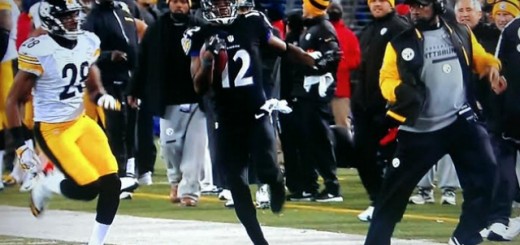This is a story that begins with a uniquely talented athlete, is littered with progressive ideas and definitions, and may end in a manner that likely hasn’t been seen in the history of the NFL. 
Jimmy Graham, the all-world “tight end” of the New Orleans Saints, who resembles a giraffe with a gym membership far more closely than a human, is set to become an unrestricted free agent this March. The Saints organization, however, has predictably vowed to prevent Graham from donning a different uniform this fall, even if that entails hitting Graham with the Franchise Tag. The “tag” is one of the most valuable chips an NFL franchise holds, in that its use allows a team to retain a player with an expiring contract for one additional season at a cost that is designed to richly reward the excellent play of its recipient. An “exclusive” franchise player, which is what the Saints would presumably make Graham, is offered the greater of the average of the top 5 salaries at the player’s position or 120% of his previous year’s salary. The “player’s position” element is therefore crucial, and represents a battleground fueled by the league’s ever-evolving nature, making this process a bit more ambiguous than what first meets the eye.
What is a tight end (“TE”)? A wide receiver (“WR”)? We thought we knew, but the landscape of the NFL has drastically changed in recent years, with multiple receiving threats of all shapes, sizes and specialties lining up in a variety of positions. Whereas your father’s TE was used as a proxy for an extra offensive lineman and occasionally went out for a 6-yard curl, your present day TE can be found lining up all over the field, threatening the defense in a down-field manner more frequently and effectively than ever. Graham is one of the league’s most feared symbols of such evolution, performing his signature dunking of the football through the goalposts following a touchdown reception an astonishing 16 times this past season. Graham led the NFL in receiving TD’s… WR’s included. So what makes him inferior to a WR, who would make an estimated $11.539M in 2014 compared to a TE’s $6.709M if tagged this spring?[i] This is a question Graham seems poised and ready to ask the powers that be, and the empirical and philosophical considerations are fascinating.
There is $4.83M hanging in the balance, contingent on how Graham’s position is defined. What that figure means to Graham is quite a bit: $4.83M represents nearly double what Graham has made in his first 4 years in the NFL combined.[ii] So how will the league determine Graham’s position, and concurrently his 2014 salary?
Article 10 of the NFL’s Collective Bargaining Agreement is the authority on the Franchise Tag and the implications of its use. Art. 10, Sect. 2(ii) provides that a player’s position shall be defined as the position “at which he participated in the most plays during the prior League Year.” An easy enough guideline to follow, right? According to ESPN Stats & Information, Graham lined up as a WR on 67% of his snaps in 2013 (45% in the slot, 22% out wide) while lining up as an “in-line” TE on the remaining 33% of his snaps.[iii]
The empirical evidence supports the notion that Jimmy Graham and his android-like abilities qualify for the WR-level salary. The Saints, however could rebut with a multitude of novel arguments. Could a TE line up out wide a certain number of times without compromising his status as a TE? What if the player initially lines up “in-line” (attached to the line of scrimmage, such as adjacent to the offensive tackle), thereby causing the defense to treat him as a TE, but then motions out into the slot prior to the snap? How about the possibility that a player blocks on a disproportionately high percentage of plays when lined up as a WR, or conversely goes out on passing routes frequently despite lining up “in-line”? The shades of grey are almost limitless, and the versatility of today’s innovative offenses, for which Saints’ Head Coach Sean Payton is a celebrated icon no less, makes matters even more difficult. The question then becomes “how will this question be settled, and by whom?”
Art. 10, Sect. 7(c) of the CBA provides that “any dispute concerning the identity and Salary of players included within each player position category… shall be submitted to and resolved by the Impartial Arbitrator…” Sometime between February 1 and February 15, Graham will likely be notified of his official label as a TE. He will then have the option to challenge such designation, whereby a neutral decision-maker will hear all relevant information and render a binding decision as to Graham’s position.
This is not the first time we’ve seen a TE outwardly state a willingness to challenge their status in anticipation of the Franchise Tag. In 2012, Jermichael Finley of the Green Bay Packers put the world on notice of his non-acceptance of the TE label. Finley appeared ready to “lawyer up” and take his claim to arbitration, fighting for the 2012 tag amount of $9.515M for WR’s instead of the $5.446M figure for TE’s. However, the team and player reached an agreement on a new deal averaging $7M per season before the case went to arbitration, representing a middle-ground compromise that appeased both sides. Last winter, a similar disagreement was on the horizon between the Tennessee Titans and Jared Cook. Again, the arbitration process was bypassed as the Titans opted not to tag Cook, instead letting him enter free agency.
We could very easily see the Saints and their prized pass catcher each drop their figurative weapons and reach an agreement on a long-term contract extension, thus rendering any determination of Graham’s position moot. The threatening clouds of positional ambiguity hovering over the league would not be mooted, however. No matter how drawn out the process to determine Graham’s position proves to be, the NFL and NFL Players Association would be wise to revisit its relevant definitions and procedures under Article 10. This situation is extremely capable of surfacing annually, and other battlegrounds may develop, such as the distinction between Defensive Ends and Linebackers (2014 Franchise Tag estimated figures of $12.475M and $10.895M respectively) whose primary on-field functions are similar (i.e., pass rushers). For now, one thing is for sure: arriving at a final resolution to this problem will be as difficult as trying to keep Graham out of the end zone. In the meantime, perhaps we will witness the league’s first Franchise Tag arbitration decision, to determine just how well compensated Graham’s inevitable end zone trips will be in 2014.


Recent Comments